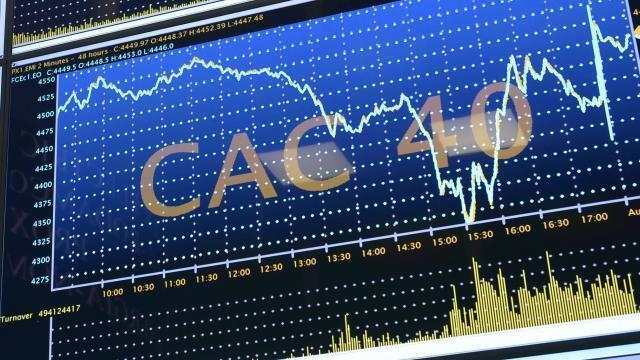(BFM Bourse) – On Thursday, the CAC 40 dropped its previous historic highs during the session, which dated from January 2022. A look back at the very eventful life of the thirty-year-old Parisian index, a reflection of the 40 flagship companies of the French economy.
Young in his thirties, the Parisian star index overcame the internet bubble of 2000, withstood the subprime crisis and then recovered from the coronavirus pandemic to reach a new record on Thursday February 16 at 7,387.29 points.
What a long way since December 31, 1987, when the value of the CAC 40 index was set by convention at 1,000 points. But it was a few months later, on June 15, 1988, that the CAC 40 was officially launched. Its acronym means “continuous assisted quotation”.
In 1994, the range of indices was enriched with the CAC 40 GR, the version of the index which included the reinvestment of dividends and which was considered to be a fairer and more serious measure of the return on shares. Then on December 1, 2003, the CAC 40 adopted a floating capitalization system in its method of calculation, ie the number of securities actually available and negotiable on the market.
Riding on the trend of the socially responsible economy, Euronext is launching the CAC 40 ESG index on March 22, 2021, which brings together 40 companies that have demonstrated the best practices from an environmental, social and governance (ESG) point of view.
A non-dividend index multiplied by 7 since its inception
Including dividends, the CAC 40 index is above 21,600 points, more than twice as high as the low point reached at the time of the Covid crisis (9,880 points). His previous record from January 2022 was 21,038 points. However, over 20 years (since February 2003), the performance of the S&P 500, a major American index which includes 500 large market capitalizations (+626%) is much higher than that of the CAC 40 including dividends (+407%).
Behind this fine performance, the CAC 40 has experienced many ups but also some very difficult times. The 2000s were good years for the star index in Paris. On September 4, 2000, he set a new closing record of 6,922 points against a backdrop of soaring indices in the euphoria of technology stocks.
Moreover, STMicroelectronics currently holds the prize for the strongest annual variation on the rise. The semiconductor specialist ended 1999 with a dizzying increase of +355%.
And a year later, the index lost 7.3% in a single day, the day of the attacks of September 11, 2001. A little less than two years later, the CAC 40 bottomed out at 2,401 points as a result of the of the internet bubble from 2000 to 2003. Before getting off to a better start. Between 2003 and 2007, the CAC 40 climbed the slope and peaked in June 2007 at a high point of 6,168 points.
History shows us that after a peak, comes a new crisis in the markets. In 2008/2009, the subprime crisis – these American mortgage loans – put a stop to the rise of the index which fell to a low point at 2,465 points in March 2009.
It was also during this financial crisis that Dexia collapsed. The Franco-Belgian bank experienced serious difficulties with the subprime crisis, penalized by FSA, its American subsidiary specializing in credit enhancement. In 2008, Dexia experienced a annus horribilis on the stock market by losing 81% of its value, making this fall the strongest annual downward variation of the Paris star index.
In 2011, the debt crisis in the euro zone also caused air pockets in all markets. Calm on the markets is returning thanks to the intervention of the European Central Bank and the International Monetary Fund (IMF).
Ten years passed without a major crisis until March 12, 2020. On that day, the index experienced the largest fall in its history, closing at -12.28%, investors abdicating in the face of the Covid-19 pandemic and its dreaded impact on the global economy. The global indices, including the CAC 40, have experienced a spectacular and almost linear rise until 2022 against a backdrop of recovery thanks to the massive support of central banks and vaccination.
Then last year, the war in Ukraine, inflation and monetary tightening caused the index to bend. The CAC 40 ends 2022 on a sad note, down 9.50% compared to December 31, 2021, the year after which it jumped 28.85%.
A quarter of the index has never changed
In more than 30 years, the Paris index has seen its composition change. It is the Scientific Council of the indices (CSI) of the Paris Bourse which decides on the integration of a value in the Holy of Holies. And some companies have remained faithful to the CAC 40, because they fulfill the criteria to be included in the Parisian stock market elite.
A quarter of the CAC 40 has therefore never left the index. The companies Air Liquide, Carrefour, Danone (ex-BSN), L’Oréal, LVMH, Michelin, Saint-Gobain, Sanofi, Société Générale and Vivendi (ex-Générale des Eaux) have achieved the feat of never having been ousted of the leading Parisian index.
Among the shareholders of these jewels of the American economy, non-resident shareholders are in the majority, in particular Anglo-Saxon pension funds which invest in the markets to make retirement savings grow, as opposed to the pay-as-you-go pension system the French. French institutional shareholders make up about a third.
As for individual shareholders, just over one and a half million bought or sold shares directly in 2022, a high figure but slightly less than in 2021, which was a record year.
(With AFP)
SS – ©2023 BFM Bourse
